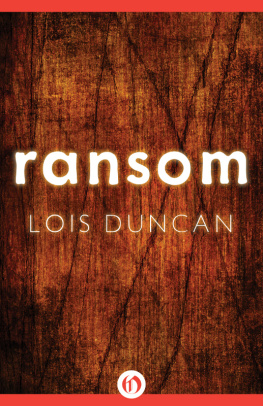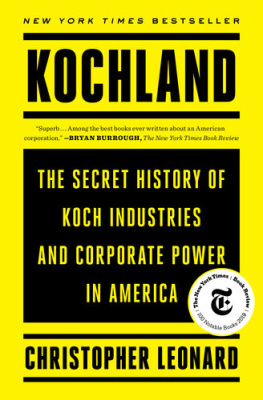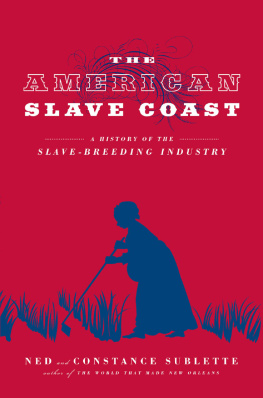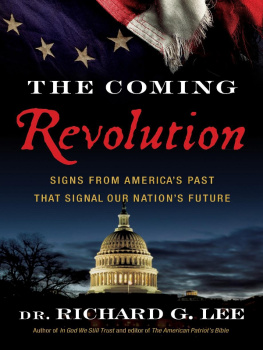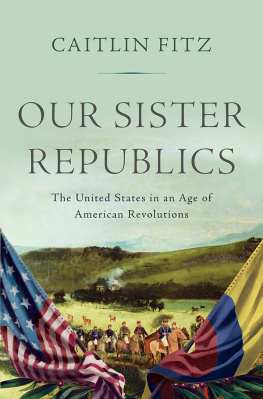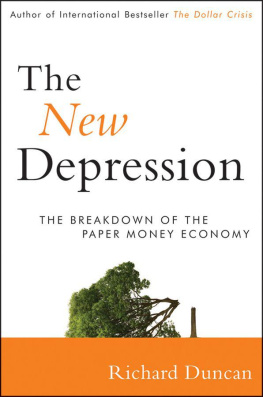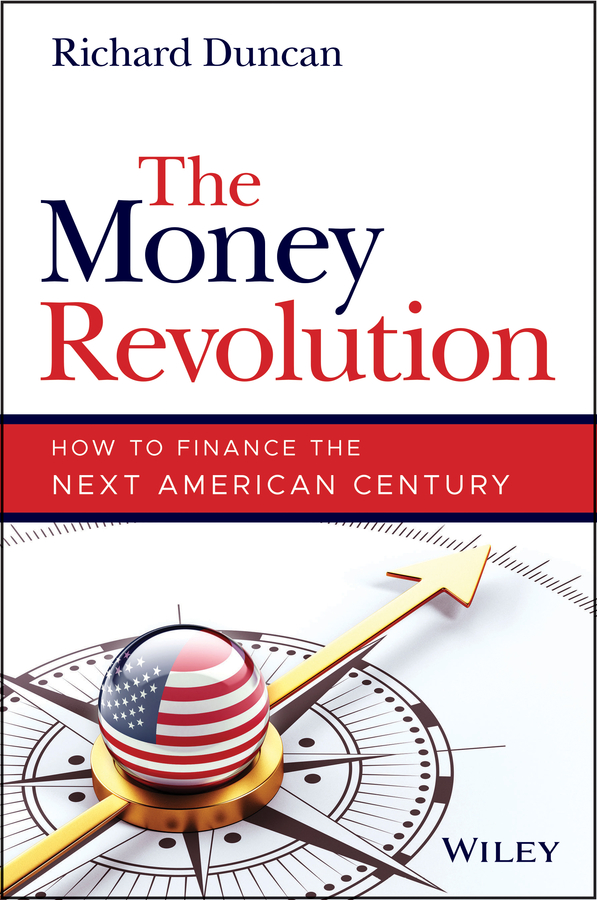
Table of Contents
List of Tables
- Chapter 1
- Chapter 4
- Chapter 8
- Chapter 9
- Chapter 17
- Chapter 18
- Chapter 21
List of Illustrations
- Chapter 1
- Chapter 2
- Chapter 3
- Chapter 4
- Chapter 5
- Chapter 6
- Chapter 7
- Chapter 8
- Chapter 9
- Chapter 10
- Chapter 11
- Chapter 12
- Chapter 13
- Chapter 14
- Chapter 15
- Chapter 17
- Chapter 18
- Chapter 19
- Chapter 20
- Chapter 21
Guide
Pages
The Money Revolution
How to Finance the Next American Century
RICHARD DUNCAN

Copyright 2022 Richard Duncan.
Registered office
John Wiley & Sons Ltd, The Atrium, Southern Gate, Chichester, West Sussex, PO19 8SQ, United Kingdom
For details of our global editorial offices, for customer services and for information about how to apply for permission to reuse the copyright material in this book please see our website at www.wiley.com.
All rights reserved. No part of this publication may be reproduced, stored in a retrieval system, or transmitted, in any form or by any means, electronic, mechanical, photocopying, recording or otherwise, except as permitted by the UK Copyright, Designs and Patents Act 1988, without the prior permission of the publisher.
Wiley publishes in a variety of print and electronic formats and by print-on-demand. Some material included with standard print versions of this book may not be included in e-books or in print-on-demand. If this book refers to media such as a CD or DVD that is not included in the version you purchased, you may download this material at http://booksupport.wiley.com. For more information about Wiley products, visit www.wiley.com.
Designations used by companies to distinguish their products are often claimed as trademarks. All brand names and product names used in this book are trade names, service marks, trademarks or registered trademarks of their respective owners. The publisher is not associated with any product or vendor mentioned in this book.
Limit of Liability/Disclaimer of Warranty: While the publisher and author have used their best efforts in preparing this book, they make no representations or warranties with respect to the accuracy or completeness of the contents of this book and specifically disclaim any implied warranties of merchantability or fitness for a particular purpose. It is sold on the understanding that the publisher is not engaged in rendering professional services and neither the publisher nor the author shall be liable for damages arising herefrom. If professional advice or other expert assistance is required, the services of a competent professional should be sought.
Library of Congress Cataloging-in-Publication Data
Names: Duncan, Richard, 1960- author.
Title: The money revolution : how to finance the next American century / Richard Duncan.
Description: Hoboken, NJ : Wiley, [2022] | Includes bibliographical references and index.
Identifiers: LCCN 2021043246 (print) | LCCN 2021043247 (ebook) | ISBN 9781119856269 (cloth) | ISBN 9781119856276 (adobe pdf) | ISBN 9781119856283 (epub)
Subjects: LCSH: FinanceUnited States. | Technological innovationsEconomic aspectsUnited States. | InvestmentsUnited States. | Monetary policyUnited States. | MoneyUnited States. | United StatesEconomic policy. | United States. Federal Reserve Board.
Classification: LCC HG181 .D85 2022 (print) | LCC HG181 (ebook) | DDC 332.10973dc23/eng/20211014
LC record available at https://lccn.loc.gov/2021043246
LC ebook record available at https://lccn.loc.gov/2021043247
Cover Design: Wiley
Cover Image: xtock/Shutterstock
With special thanks to everyone who has subscribed to Macro Watch during the last eight years.
Your financial support has made this book possible.
Introduction
Over the last century, wars, depressions, political ambition, regulatory mistakes, greed, and geopolitical competition have entirely transformed the monetary system of the United States. They have transformed the very nature of money itself. A momentous and irreversible turning point occurred five decades ago when dollars ceased to be backed by gold. Afterwards, a worldwide credit bubble took shape that fundamentally changed the structure of the global economy and the rules that govern how it functions.
That bubble and the global civilization it has created will not survive if left to market forces. Therefore, we have two choices. We can allow the bubble to implode and hope to live through the ensuing cataclysm, which could be far worse than the one that shook the world from 1930 to 1945, following the collapse of an earlier and smaller credit bubble. Alternatively, we can learn how to effectively manage our new economic system to ensure that it prospers rather than disintegrates.
A dangerous pessimism, based on a misunderstanding of how the economy works today, is becoming entrenched in the minds of far too many Americans. Proponents of the Austrian School of Economics preach that due to the United States' egregious transgressions in abandoning sound money and balanced budgets, a harsh day of reckoning inevitably awaits us in the near future, with many arguing, perversely, that since our economic Judgement Day cannot be prevented, the sooner it arrives, the better.
While it is certainly true that the US economy would collapse into a new great depression if the policies advocated by the Austrian economists were implemented, it is absolutely not true that the doom they foretell is either imminent or inevitable.
This book rejects that pessimistic and debilitating philosophy and argues instead that the new economic environment we find ourselves in today presents us with previously unimaginable opportunities to grow and prosper by investing in the industries of the future on an unprecedented scale. It explains that our economic system has been profoundly altered by the evolution of money and the proliferation of credit over the last century; that, in fact, a Money Revolution has occurred.
Once the nature of our current economic system is properly understood, the correct path forward becomes clear. If we adopt that path our economic future will be bright. This book explains how our economy works now and the opportunities it presents us.
The Money Revolution is divided into three parts. , Money, describes the evolution of money and monetary policy in the United States from the establishment of the Federal Reserve System in 1913 to the eve of the financial crisis of 2008. It also discusses the events that forced the US monetary system to evolve. These seven chapters provide a history of the Federal Reserve System and explain everything necessary to understand how the Fed conducts monetary policy in the twenty-first century. They also demonstrate the colossal power the US central bank has at its disposal.
, Credit, shows that as the nature of money changed, it brought about a transformation of the economic system as well. It describes the astonishing proliferation of credit in the United States during the five decades since dollars ceased to be backed by gold. It discusses the impact that very rapid credit growth has had on the US economy and shows that economic growth is now dependent on credit growth. It also demonstrates that there are effectively no longer any limits as to how much money the United States government can borrow. Moreover, it shows that if credit fails to expand, the economy will collapse into a depression. Next, it describes the Fed's successful policy response to the financial crisis of 2008 and its current efforts to support the economy through the COVID-19 pandemic. It ends with a survey of the causes of inflation over the last century.
Next page





